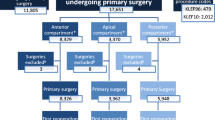Abstract
The objectives of this prospective study were to determine the prevalence of pelvic organ prolapse (POP) after colposuspension and to investigate possible preoperative and operative risk factors. Seventy-seven women who underwent colposuspension between 1996 and 1997 were investigated. POP was assessed before colposuspension using the pelvic organ prolapse quantification system (POPQ). Women were reassessed at one and seven to eight years (or when referred with symptomatic POP). By seven to eight years, of the 77 women, 29 (38%) had developed symptomatic prolapse, 29 (38%) had asymptomatic prolapse, 7 (9%) had no symptoms and no prolapse, and 12 (15%) could not be assessed. POP at one year was significantly associated with the presence of posterior vaginal descent before colposuspension (odds ratio 3.07, 95% CI 1.10–8.60, p=0.03). No variable reached statistical significance by eight years postcolposuspension. In conclusion, this is the first study to assess POP prospectively using a validated method before and after colposuspension. The results add support to the view that there is an association between colposuspension and the development of symptomatic POP (requiring surgery).


Similar content being viewed by others
Abbreviations
- POP:
-
Pelvic organ prolapse
- POPQ:
-
Pelvic organ prolapse quantification system
- SUI:
-
Stress urinary incontinence
References
Lapitan MC, Cody DJ, Grant AM (2004) Open retropubic colposuspension for urinary incontinence in women (Cochrane Review). The Cochrane Library. Issue 4. Chichester, UK, John Wiley and Sons, Ltd
Burch JC (1968) Cooper's ligament urethrovesical suspension for stress incontinence. Nine years' experience—results, complications, technique. Am J Obstet Gynecol 100(6):764–774
Jarvis GJ (1994) Surgery for genuine stress incontinence. Br J Obstet Gynaecol 101(5):371–374
Stanton SL, Williams LE, Ritchie D (1976) The colposuspension operation for urinary incontinence. Br J Obstet Gynaecol 83(11):890–895
Eriksen BC, Hagen B, Eik-Nes SH, Molne K, Mjolnerod OK, Romslo I (1990) Long-term effectiveness of the Burch colposuspension in female urinary stress incontinence. Acta Obstet Gynecol Scand 69(1):45–50
Wiskind AK, Creighton SM, Stanton SL (1992) The incidence of genital prolapse after the Burch colposuspension. Am J Obstet Gynecol 167(2):399–404
Kjolhede P, Ryden G (1994) Prognostic factors and long-term results of the Burch colposuspension. A retrospective study. Acta Obstet Gynecol Scand 73(8):642–647
Langer R, Lipshitz Y, Halperin R, Pansky M, Bukovsky I, Sherman D (2001) Long-term (10–15 years) follow-up after Burch colposuspension for urinary stress incontinence. Int Urogynecol J Pelvic Floor Dysfunct 12(5):323–326
Dietz HP, Wilson PD (2000) Colposuspension success and failure: a long-term objective follow-up study. Int Urogynecol J Pelvic Floor Dysfunct 11(6):346–351
Kwon CH, Culligan PJ, Koduri S, Goldberg RP, Sand PK (2003) The development of pelvic organ prolapse following isolated Burch retropubic urethropexy. Int Urogynecol J Pelvic Floor Dysfunct 14(5):321–325
Bombieri L, Perkins EP, Williams M, Shaw SR, Freeman RM (2002) Why do women develop voiding dysfunction and de novo detrusor instability after colposuspension? BJOG 109:402
Abrams P, Cardozo L, Fall M, Griffiths D, Rosier P, Ulmsten U et al (2002) The standardisation of terminology of lower urinary tract function: report from the standardisation sub-committee of the International Continence Society. Neurourol Urodyn 21:167–178
Bump RC, Mattiasson A, Bo K, Brubaker LP, DeLancey JO, Klarskov P et al (1996) The standardization of terminology of female pelvic organ prolapse and pelvic floor dysfunction. Am J Obstet Gynecol 175(1):10–17
Hall AF, Theofrastous JP, Cundiff GW, Harris RL, Hamilton LF, Swift SE et al (1996) Interobserver and intraobserver reliability of the proposed International Continence Society, Society of Gynecologic Surgeons, and American Urogynecologic Society pelvic organ prolapse classification system. Am J Obstet Gynecol 175(6):1467–1470
Bombieri L, Freeman RM, Perkins EP, Williams MP, Shaw SR (2002) Objective assessment of bladder neck elevation and urethral compression at colposuspension. BJOG 109(4):395–401
Burnand B, Kernan WN, Feinstein AR(1990) Indexes and boundaries for “quantitative significance” in statistical decisions. J Clin Epidemiol 43(12):1273–1284
Nichols DH (1985) Vaginal prolapse affecting bladder function. Urol Clin North Am 12(2):329–338
Kjolhede P, Noren B, Ryden G (1996) Prediction of genital prolapse after Burch colposuspension. Acta Obstet Gynecol Scand 75(9):849–854
Swift S, Woodman P, O'Boyle A, Kahn M, Valley M, Bland D et al (2005) Pelvic Organ Support Study (POSST): the distribution, clinical definition, and epidemiologic condition of pelvic organ support defects. Am J Obstet Gynecol 192(3):795–806
Olsen AL, Smith VJ, Bergstrom JO, Colling JC, Clark AL (1997) Epidemiology of surgically managed pelvic organ prolapse and urinary incontinence. Obstet Gynecol 89(4):501–506
Ward KL, Hilton P (2004) A prospective multicenter randomized trial of tension-free vaginal tape and colposuspension for primary urodynamic stress incontinence: two-year follow-up. Am J Obstet Gynecol 190(2):324–331
Author information
Authors and Affiliations
Corresponding author
Rights and permissions
About this article
Cite this article
Auwad, W., Bombieri, L., Adekanmi, O. et al. The development of pelvic organ prolapse after colposuspension: a prospective, long-term follow-up study on the prevalence and predisposing factors. Int Urogynecol J 17, 389–394 (2006). https://doi.org/10.1007/s00192-005-0024-3
Received:
Accepted:
Published:
Issue Date:
DOI: https://doi.org/10.1007/s00192-005-0024-3




